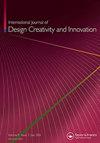The effect of design education on creative design cognition of high school students
IF 2.5
Q4 ENGINEERING, MANUFACTURING
International Journal of Design Creativity and Innovation
Pub Date : 2019-06-17
DOI:10.1080/21650349.2019.1628664
引用次数: 10
Abstract
ABSTRACT This paper presents results from a study exploring the relationship between design education and creative design cognition in high school students. Data from coded protocols of high school students with and without design education serve as the source. Audio/video recordings of student pairs engaged in a design task captured both their design approach and their concurrent design conversation. Following a verbal protocol methodology, videos were coded using the Function-Behaviour-Structure ontology coding scheme. This coding scheme was augmented by two further codes ‘new’ and ‘surprising’ as the basis for measuring design creativity. Results revealed significant differences between the two cohorts in creative design cognition, while no significant differences in general design cognition were found.设计教育对中学生创造性设计认知的影响
本文介绍了一项研究的结果,该研究探讨了高中生的设计教育与创造性设计认知之间的关系。来自受过设计教育和未受过设计教育的高中生的编码协议的数据是来源。参与设计任务的学生对的录音/视频记录了他们的设计方法和同时进行的设计对话。遵循口头协议方法,使用功能-行为-结构本体编码方案对视频进行编码。这一编码方案又增加了两个“新”和“令人惊讶”的代码,作为衡量设计创造力的基础。结果显示,两组人群在创意设计认知方面存在显著差异,而在一般设计认知方面没有发现显著差异。
本文章由计算机程序翻译,如有差异,请以英文原文为准。
求助全文
约1分钟内获得全文
求助全文
来源期刊

International Journal of Design Creativity and Innovation
ENGINEERING, MANUFACTURING-
CiteScore
3.80
自引率
27.80%
发文量
15
期刊介绍:
The International Journal of Design Creativity and Innovation is an international publication that provides a forum for discussing the nature and potential of creativity and innovation in design from both theoretical and practical perspectives. Design creativity and innovation is truly an interdisciplinary academic research field that will interest and stimulate researchers of engineering design, industrial design, architecture, art, and similar areas. The journal aims to not only promote existing research disciplines but also pioneer a new one that lies in the intermediate area between the domains of systems engineering, information technology, computer science, social science, artificial intelligence, cognitive science, psychology, philosophy, linguistics, and related fields. The journal covers, but is not restricted to, the following topics: ·Theories on Design Creativity and Innovation ·Cognition of Design Creativity ·Innovative Process ·Inventive Process ·Analogical Reasoning for Design Creativity and Innovation ·Design Synthesis ·Method and Tools for Design Creativity and Innovation ·Representation of Design Creativity and Innovation ·Education for Design Creativity and Innovation ·Concept Generation and Inspiration.
 求助内容:
求助内容: 应助结果提醒方式:
应助结果提醒方式:


